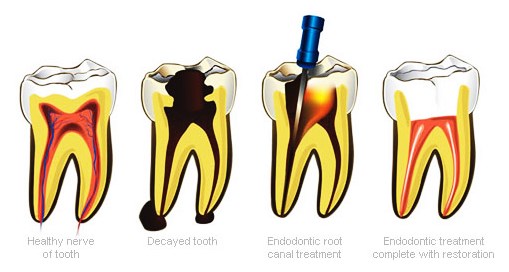 RCT as it is commonly called refers to the process of removal of the infected pulp of a badly carious tooth and is treated by various medicinal solutions to make it sterile. Later the tooth is restored and made functional by placing a crown. The procedure is relatively painless although slight discomfort can be attributed during removal of infected tissues during which a proper anesthetic is used. Normally this can take a single visit or multiple visits depending on the condition of the tooth.
RCT as it is commonly called refers to the process of removal of the infected pulp of a badly carious tooth and is treated by various medicinal solutions to make it sterile. Later the tooth is restored and made functional by placing a crown. The procedure is relatively painless although slight discomfort can be attributed during removal of infected tissues during which a proper anesthetic is used. Normally this can take a single visit or multiple visits depending on the condition of the tooth. Severe pain on an infected tooth
Severe pain on an infected tooth Painful tooth to chew on
Painful tooth to chew on Swelling associated with the jaw
Swelling associated with the jaw Tooth which are severely worn out
Tooth which are severely worn out This is the most common dental treatment performed and it removes the hard tartar and plaque which forms around teeth. The presence of calcified plaques leads to gum diseases like bleeding from gums. Based on the degree of the stains and plaques it might take 1 to 2 appointments to finish the procedure.
This is the most common dental treatment performed and it removes the hard tartar and plaque which forms around teeth. The presence of calcified plaques leads to gum diseases like bleeding from gums. Based on the degree of the stains and plaques it might take 1 to 2 appointments to finish the procedure.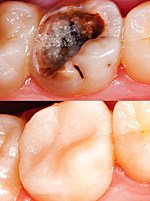 Composite restorations of tooth are natural looking tooth colored fillings which are used to repair tooth that are infected, broken, or fractured. The provide a cosmetic appeal and are durable. These can be closely matched to the nearby tooth and will look natural and can be used in the front or back teeth.
Composite restorations of tooth are natural looking tooth colored fillings which are used to repair tooth that are infected, broken, or fractured. The provide a cosmetic appeal and are durable. These can be closely matched to the nearby tooth and will look natural and can be used in the front or back teeth. Chipped front tooth
Chipped front tooth Space closure between teeth
Space closure between teeth Cracked or broken teeth
Cracked or broken teeth Crowns and bridges are fixed appliances which are cemented on a tooth or supporting structures to replace a missing tooth. A crown covers a tooth completely and strengthens it and restores its function.
Crowns and bridges are fixed appliances which are cemented on a tooth or supporting structures to replace a missing tooth. A crown covers a tooth completely and strengthens it and restores its function. In case of a very large defect or decay of tooth
In case of a very large defect or decay of tooth Fractured tooth
Fractured tooth Root canal treated tooth
Root canal treated tooth Dental implants
Dental implants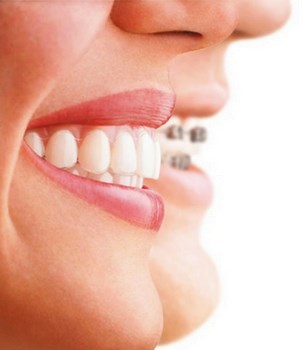 Orthodontic treatment aims at aligning the teeth at a more desirable position for improving the appearance and to restore the normal functions of teeth and jaws.
Orthodontic treatment aims at aligning the teeth at a more desirable position for improving the appearance and to restore the normal functions of teeth and jaws.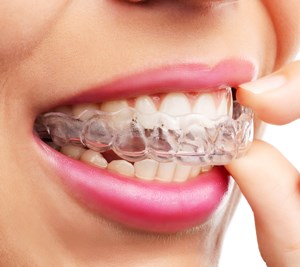 Another contemporary type of treatment alternative to the traditional braces is use of clear aligners.
Another contemporary type of treatment alternative to the traditional braces is use of clear aligners. Post and core is a type of replacement given to extensively damaged tooth. When a tooth is is not restorable with a normal filling due to compromised structure, a post and core is used to reinforce its strength.
Post and core is a type of replacement given to extensively damaged tooth. When a tooth is is not restorable with a normal filling due to compromised structure, a post and core is used to reinforce its strength.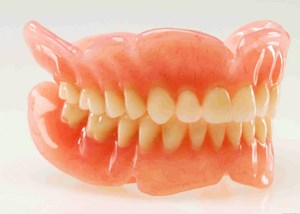 Complete dentures are removable, prosthetic replacements of the teeth and supporting tissues. These dentures are usually made of acrylic base supported with full set of teeth. Based on the time they are fabricated, there can be conventional dentures and immediate type of dentures.
Complete dentures are removable, prosthetic replacements of the teeth and supporting tissues. These dentures are usually made of acrylic base supported with full set of teeth. Based on the time they are fabricated, there can be conventional dentures and immediate type of dentures.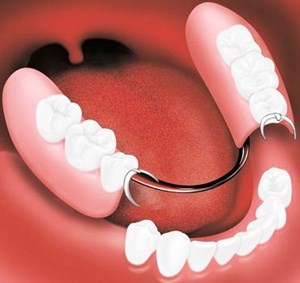 Partial dentures are removable, prosthetic appliances which replace one or more missing teeth. Similar to complete dentures, they have an acrylic base supporting the tooth.
Partial dentures are removable, prosthetic appliances which replace one or more missing teeth. Similar to complete dentures, they have an acrylic base supporting the tooth.  Dental implants are fixed tooth replacements which serve all the functions of natural teeth with the support of screws placed inside the bone. These are an effective solution for those who need a functional and esthetic replacement for their missing teeth. Implants make it possible for people who either cannot or will not wear a conventional denture to have very firm, stable and visually attractive teeth.
Dental implants are fixed tooth replacements which serve all the functions of natural teeth with the support of screws placed inside the bone. These are an effective solution for those who need a functional and esthetic replacement for their missing teeth. Implants make it possible for people who either cannot or will not wear a conventional denture to have very firm, stable and visually attractive teeth. Tooth whitening is the technique of lightening the colour of the tooth with mild bleaching agents. It can remove the stains due to external agents like coffee, tea, tobacco etc as well as due to age factors.
Tooth whitening is the technique of lightening the colour of the tooth with mild bleaching agents. It can remove the stains due to external agents like coffee, tea, tobacco etc as well as due to age factors. Veneers & Laminates are used for reasons like to lighten stains, close gaps and even alter crooked or malformed teeth. They are considerably more durable and stain resistant than bonding.
Veneers & Laminates are used for reasons like to lighten stains, close gaps and even alter crooked or malformed teeth. They are considerably more durable and stain resistant than bonding.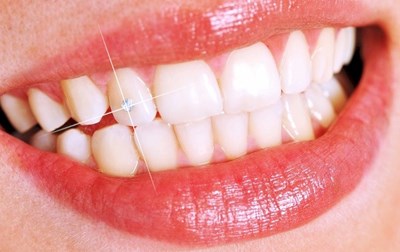 In today’s world, everyone is self-conscious about their appearance and smile. They are looking for various treatments like body art and cosmetic dental treatments to achieve the desired aesthetic appearance, attention, to make a fashion statement and to be unique among the crowd.
In today’s world, everyone is self-conscious about their appearance and smile. They are looking for various treatments like body art and cosmetic dental treatments to achieve the desired aesthetic appearance, attention, to make a fashion statement and to be unique among the crowd. Tooth decay: Lasers are used to remove decay within a tooth and prepare the surrounding enamel for receipt of the filling. Lasers are also used to "cure" or harden a filling.
Tooth decay: Lasers are used to remove decay within a tooth and prepare the surrounding enamel for receipt of the filling. Lasers are also used to "cure" or harden a filling. Gum disease: Lasers are used to reshape gums and remove bacteria during root canal procedures.
Gum disease: Lasers are used to reshape gums and remove bacteria during root canal procedures. Biopsy or lesion removal: Lasers can be used to remove a small piece of tissue (called a biopsy) so that it can be examined for cancer. Lasers are also used to remove lesions in the mouth and relieve the pain of canker sores.
Biopsy or lesion removal: Lasers can be used to remove a small piece of tissue (called a biopsy) so that it can be examined for cancer. Lasers are also used to remove lesions in the mouth and relieve the pain of canker sores. Teeth whitening: Lasers are used to speed up in-office teeth whitening procedures. A peroxide bleaching solution, applied to the tooth surface, is ''activated" by laser energy, which speeds up of the whitening process.
Teeth whitening: Lasers are used to speed up in-office teeth whitening procedures. A peroxide bleaching solution, applied to the tooth surface, is ''activated" by laser energy, which speeds up of the whitening process. Pits & Fissure Sealants: Sealing the pits & fissures of molar teeth using tooth colored material to prevent decay.
Pits & Fissure Sealants: Sealing the pits & fissures of molar teeth using tooth colored material to prevent decay. Fluoride application: Preventive treatment aimed to combat decay.
Fluoride application: Preventive treatment aimed to combat decay. Space maintainers: Guarding/Preserving the space required for the eruption of permanent teeth.
Space maintainers: Guarding/Preserving the space required for the eruption of permanent teeth. Stainless Steel Crowns: Crowns given for weak, milk teeth.
Stainless Steel Crowns: Crowns given for weak, milk teeth. Pulpectomy: Treatment for infected milk teeth.
Pulpectomy: Treatment for infected milk teeth. Habit breaking appliances: To correct habits like thumb sucking, nail biting, mouth breathing etc.....
Habit breaking appliances: To correct habits like thumb sucking, nail biting, mouth breathing etc..... Myofunctional appliances: To rectify the alignment of milk teeth with the support of Upper & Lower jaw bones & facial muscles, during the growing phase.
Myofunctional appliances: To rectify the alignment of milk teeth with the support of Upper & Lower jaw bones & facial muscles, during the growing phase.
SHARE THIS PAGE!